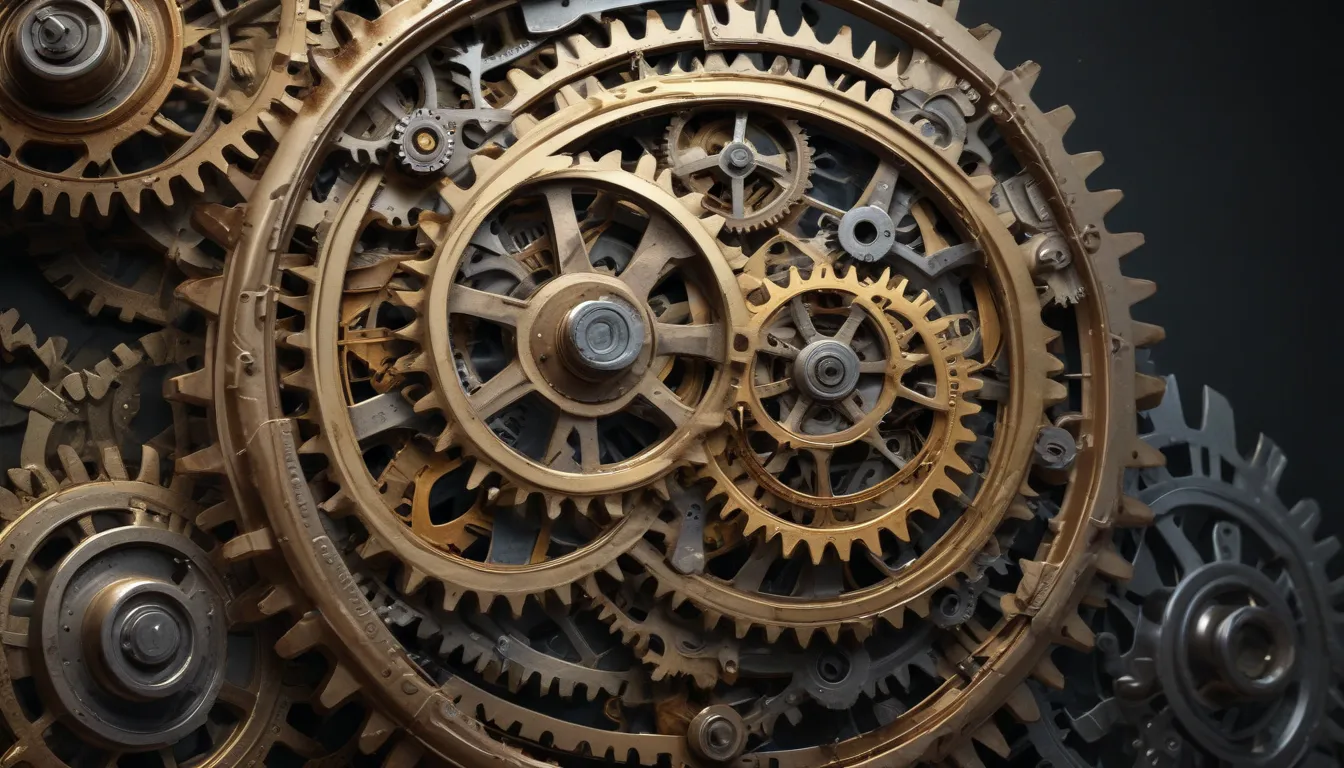A Note About Images: The images used in our articles are for illustration purposes only and may not exactly match the content. They are meant to engage readers, but the text should be relied upon for accurate information.
Gears are remarkable mechanical components that have played an essential role throughout history, powering machines and vehicles and contributing to the advancement of modern technology. Understanding the science behind gears can provide valuable insights into their functionality and significance in various applications. In this article, we will explore 18 fascinating facts about gears, shedding light on their history, mechanics, and diverse uses. Whether you are a curious enthusiast or a professional looking to expand your knowledge, these facts will take you on a journey to uncover the captivating world of gears, offering a blend of technical details and captivating insights.
Key Takeaways:
- Gears are ancient yet essential mechanical devices that convert speed and torque, driving progress across industries.
- The study of gears falls under mechanical engineering, involving complex calculations and precise tooth profiles.
- Gears are crucial in automotive, industrial, and renewable energy sectors, contributing to modern society’s functionality.
Gears: Mechanical Marvels
Gears are mechanical devices that transmit motion and power through the meshing of toothed wheels. They are an essential component in various machines, including cars, bicycles, and industrial equipment. These intricate components enable the efficient transfer of power, enabling machines to operate smoothly and effectively.
Dive into Gear Varieties
Gears come in various types, such as spur gears, helical gears, bevel gears, and worm gears, each designed for specific applications and operating conditions. Understanding the different types of gears allows engineers and designers to choose the most suitable option for their specific needs, ensuring optimal performance and efficiency.
Unraveling the History of Gears
The history of gears dates back to ancient times, with evidence of gear mechanisms found in artifacts from civilizations such as the Greeks and the Chinese. Gears have played a crucial role in shaping human history, enabling the development of machinery for various sectors, including manufacturing, transportation, and more.
Gears in the Industrial Revolution
Gears played a pivotal role in the Industrial Revolution, revolutionizing the way machinery was developed for manufacturing, transportation, and other sectors. The widespread adoption of gears during this period accelerated progress and laid the foundation for modern industrial practices.
The Heart of Automotive Transmissions
Gears play a crucial role in automotive transmissions, allowing for the smooth transfer of power from the engine to the wheels. The intricate design of gears in automotive systems ensures that vehicles can operate efficiently and effectively, providing the necessary speed and torque for a smooth driving experience.
Balancing Speed and Torque
Gears enable the conversion of speed and torque, allowing machines to operate efficiently across a wide range of speeds and loads. The careful calibration of gear ratios ensures that machinery can perform optimally, balancing speed and torque to achieve the desired mechanical output.
Gears in Everyday Life
Gears are found in everyday objects, from clocks and watches to power tools and escalators, showcasing their widespread utility. These essential components are part of our daily lives, often functioning behind the scenes to ensure the smooth operation of various devices and systems.
Precision in Tooth Profiles
The efficient functioning of gears relies on precise tooth profiles and alignments to ensure smooth and reliable power transmission. The careful design and manufacturing of gears are essential to maintain their functionality and durability over time, highlighting the importance of precision in tooth profiles.
Influence of Gear Ratios
Gear ratios determine the relationship between input and output speeds and torques, influencing the performance of machinery and vehicles. By adjusting the gear ratios, engineers can optimize the efficiency and functionality of a system, ensuring that it operates at its full potential.
The Role of Lubrication
Proper lubrication is crucial for gears to operate smoothly and minimize wear, extending their lifespan and maintaining efficiency. Regular maintenance and lubrication are essential to ensure that gears can function optimally, reducing friction and ensuring a longer lifespan for the components.
Gears in Robotics and Automation
Gears are integral components in robotics and automation systems, facilitating precise and controlled movement in various applications. The use of gears in these advanced systems allows for accurate positioning and operation, enabling robots to perform complex tasks with precision and efficiency.
Mechanical Engineering at its Core
The study of gears falls under the field of mechanical engineering, encompassing the design, analysis, and application of gear systems. Mechanical engineers play a vital role in developing and optimizing gear systems to meet specific needs and requirements, driving innovation and progress in various industries.
Maintenance and Wear
Over time, gears are subject to wear and fatigue due to the stresses of operation, necessitating regular maintenance and, in some cases, replacement. Proper care and maintenance of gear systems are essential to ensure their longevity and optimal performance, preventing premature wear and costly repairs.
Complexity of Gear Design
The design of gears involves complex calculations to ensure optimal performance, considering factors such as load distribution and tooth profiles. Engineers utilize sophisticated tools and techniques to design gear systems that meet specific requirements, balancing performance, durability, and efficiency.
Gears in Power Generation
Gears are employed in wind turbines to convert the low-speed rotation of the blades into high-speed rotation for power generation. The use of gears in renewable energy systems highlights their versatility and importance in enabling sustainable power generation solutions, contributing to a greener future.
Essential in Heavy Machinery
Gears are crucial in heavy machinery such as cranes and excavators, providing the necessary torque and control for their operation. These robust components enable the efficient operation of heavy equipment, ensuring that they can perform complex tasks with precision and reliability.
Advancement in Gear Technology
The advancement of gear technology continues, with ongoing research and development aimed at enhancing efficiency, durability, and performance. Engineers and researchers are constantly exploring new materials, designs, and manufacturing processes to push the boundaries of gear technology, driving innovation and progress in various industries.
Gears: Pillars of Modern Society
Gears are integral to modern society, driving progress across industries and contributing to the functionality of countless machines and systems. From transportation to manufacturing, gears play a vital role in powering our technological infrastructure, shaping the world we live in and enabling the advancement of society.
Gears are fascinating mechanical components that have shaped the course of human history and continue to play a vital role in modern technology and industry. From their ancient origins to their diverse applications in automotive, industrial, and renewable energy sectors, gears have continuously evolved to meet the demands of technology and innovation. Understanding the fundamental principles and diverse types of gears provides valuable insights into their functionality and importance. As gears continue to drive progress and innovation, their impact on modern society remains profound, reflecting their indispensable role in shaping the world we live in.
Conclusion
In conclusion, gears are fascinating mechanical components that play a crucial role in various machines and systems. From their historical significance to their modern applications in industries and everyday devices, gears have continuously evolved to meet the demands of technology and innovation. Understanding the fundamental principles and diverse types of gears provides valuable insights into their functionality and importance. As we continue to advance in engineering and manufacturing, the significance of gears in facilitating motion, torque, and speed transmission remains unwavering, making them an indispensable aspect of our technological landscape.
Gears are truly the unsung heroes of the mechanical world, powering our machines, vehicles, and systems with precision and efficiency. Their intricate design and functionality continue to amaze and inspire engineers, designers, and enthusiasts alike, driving progress and innovation in various industries. As we unravel the mysteries of gears and delve deeper into their world, we gain a deeper appreciation for these remarkable components that shape the world we live in.
FAQs
-
What are the different types of gears? There are several types of gears, including spur gears, helical gears, bevel gears, worm gears, and rack and pinion gears. Each type serves specific purposes based on the application’s requirements and mechanical design.
-
How do gears contribute to mechanical advantage? Gears contribute to mechanical advantage by transmitting motion and force from one component to another, allowing for the amplification or reduction of speed and torque, depending on the gear ratio and configuration.
Gears play a vital role in our lives, from ancient times to modern marvels. Delving deeper into the world of gears, you’ll find intriguing facts about Metal Gear, a beloved video game franchise that combines stealth and action. For those looking to shift their knowledge into high gear, exploring the extraordinary facts about Get Your Rear In Gear will provide a thrilling ride. And if you’re seeking a unique blend of gears and refreshing beverages, the Ohiopyle Beer And Gear Festival offers an unforgettable experience that combines the best of both worlds.
Our commitment to delivering trustworthy and engaging content is at the heart of what we do. Each fact on our site is contributed by real users like you, bringing a wealth of diverse insights and information. To ensure the highest standards of accuracy and reliability, our dedicated editors meticulously review each submission. This process guarantees that the facts we share are not only fascinating but also credible. Trust in our commitment to quality and authenticity as you explore and learn with us.






